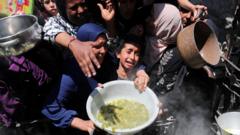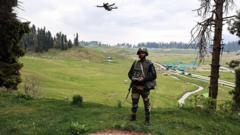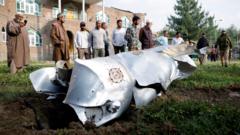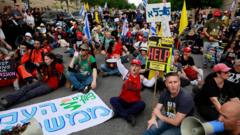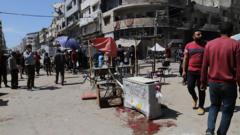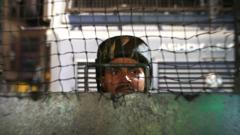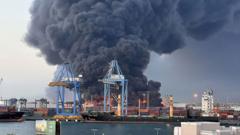As Myanmar grapples with the aftermath of a catastrophic earthquake, the death toll has surpassed 1,600, with many residents resorting to manual digging for survivors. The country faces significant obstacles, including broken communication lines and damaged infrastructure, impeding rescue operations. The Red Cross estimates that over 90 individuals remain trapped in collapsed buildings, prompting local and international responses to the crisis. Power outages and ongoing military actions compound the difficulties faced in relief efforts.
Myanmar Earthquake Death Toll Exceeds 1,600 Amid Ongoing Rescue Efforts
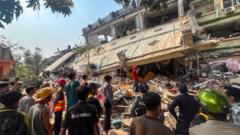
Myanmar Earthquake Death Toll Exceeds 1,600 Amid Ongoing Rescue Efforts
Fatalities rise in Myanmar as rescuers navigate debris with limited resources, desperately searching for survivors.
The devastating earthquake that struck Myanmar has claimed the lives of more than 1,600 individuals, as communities scramble in a desperate search for any remaining survivors. Witnesses have reported using their bare hands to sift through rubble in various locations, reflecting a severe lack of rescue equipment and resources. Communication systems have been severely disrupted due to damaged infrastructure, and many roads and bridges have been rendered unusable, further complicating rescue and aid efforts.
The earthquake's epicenter is in Mandalay, the nation's second-largest city, where most buildings have been flattened. Amidst the chaos, there was a glimmer of hope when rescue teams successfully pulled a woman from the debris of a collapsed 12-story apartment block approximately 30 hours post-quake. Tragically, the Red Cross warns that over 90 people remain trapped within that structure alone. In a nearby township, the bodies of 12 preschool children and a teacher have been recovered from the ruins of a kindergarten.
International assistance is beginning to arrive, but many of the most affected areas remain unreachable. Locals have resorted to improvising rescue efforts; videos circulating on social media depict scenes where individuals work tirelessly to free those trapped beneath concrete slabs. One rescuer reported the insurmountable challenge posed by a lack of tools while another lamented the inability to communicate effectively with other teams due to downed phone lines.
A frustrated local resident described the chaotic rescue environment: "There is no coordination in the rescue efforts. If we find dead bodies, we don't even know where to send them; hospitals are overwhelmed." The destruction in Mandalay is staggering, with more than 1,500 buildings reported damaged, and services such as electricity are on hold, potentially for days.
Mandalay airport, essential for facilitating aid, has been rendered non-functional after its runways sustained damage. The military junta governing the country has set up temporary medical facilities; however, access remains limited due to the collapse of key infrastructure.
Additionally, the aftermath is further complicated by ongoing military operations, including airstrikes against ethnic groups amid the humanitarian crisis. This has drawn condemnation from international bodies; the UN's special rapporteur urged an immediate halt to the military's actions, highlighting the profound impact on civilian welfare during such a disaster.
The situation in Myanmar remains dire as the country strives to recover from this tragedy, facing both natural and man-made adversities in its quest for survival and rebuilding.
The earthquake's epicenter is in Mandalay, the nation's second-largest city, where most buildings have been flattened. Amidst the chaos, there was a glimmer of hope when rescue teams successfully pulled a woman from the debris of a collapsed 12-story apartment block approximately 30 hours post-quake. Tragically, the Red Cross warns that over 90 people remain trapped within that structure alone. In a nearby township, the bodies of 12 preschool children and a teacher have been recovered from the ruins of a kindergarten.
International assistance is beginning to arrive, but many of the most affected areas remain unreachable. Locals have resorted to improvising rescue efforts; videos circulating on social media depict scenes where individuals work tirelessly to free those trapped beneath concrete slabs. One rescuer reported the insurmountable challenge posed by a lack of tools while another lamented the inability to communicate effectively with other teams due to downed phone lines.
A frustrated local resident described the chaotic rescue environment: "There is no coordination in the rescue efforts. If we find dead bodies, we don't even know where to send them; hospitals are overwhelmed." The destruction in Mandalay is staggering, with more than 1,500 buildings reported damaged, and services such as electricity are on hold, potentially for days.
Mandalay airport, essential for facilitating aid, has been rendered non-functional after its runways sustained damage. The military junta governing the country has set up temporary medical facilities; however, access remains limited due to the collapse of key infrastructure.
Additionally, the aftermath is further complicated by ongoing military operations, including airstrikes against ethnic groups amid the humanitarian crisis. This has drawn condemnation from international bodies; the UN's special rapporteur urged an immediate halt to the military's actions, highlighting the profound impact on civilian welfare during such a disaster.
The situation in Myanmar remains dire as the country strives to recover from this tragedy, facing both natural and man-made adversities in its quest for survival and rebuilding.

